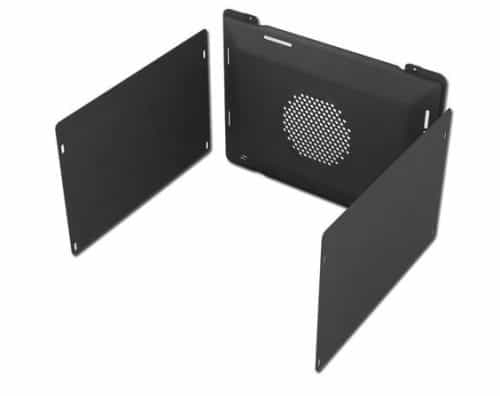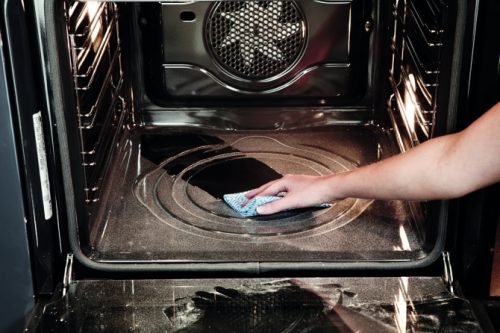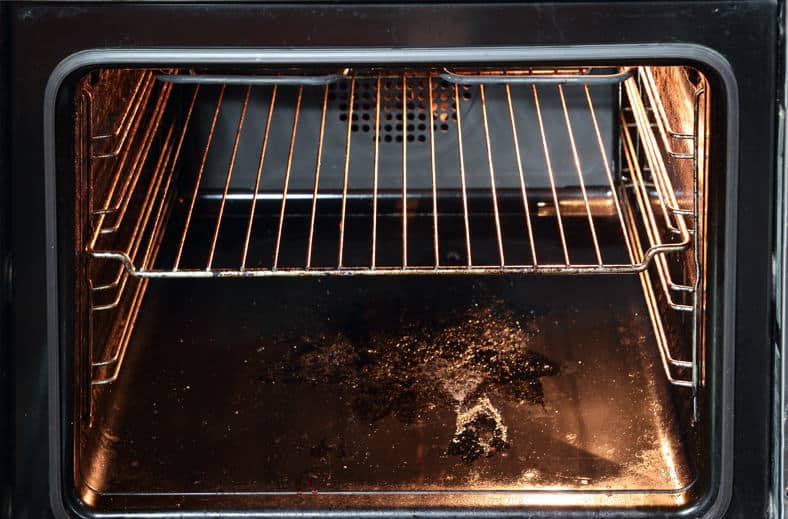Catalytic liners can often be found in the ovens of high-end cookers, but what are they and what do they do?
A catalytic liner is used to cover the surfaces inside your oven to make regular cleaning easier. During the daily use of the oven, the liner absorbs grease dirt, keeping it looking tidy. Every month a self-cleaning cycle is run to heat the liner and loosen dirt so it can be easily wiped away.
Ovens fitted with these liners are likely to cost more than those without them. Some people believe that they are worth the extra expense, but others don’t’ feel they make enough of a difference to the cleanliness of their oven. To find out whether they’re worth getting for your oven, let’s take a closer look at the details and find out about some alternative options.
What are self-cleaning ovens?
Typically, cleaning the oven is one of those jobs you dread and put off for as long as possible. Burnt-on spills and food particles stick to the sides, requiring strong chemicals and hours of scrubbing to remove. Self-cleaning ovens claim to be the solution to this tiresome routine, but even with ‘self-cleaning’ ovens, there’s likely to still be some light scrubbing needed.

The two most common types of self-cleaning ovens are catalytic and pyrolytic. Both work according to the same basic principle; absorbing or containing food messes until the self-cleaning cycle begins. The self-cleaning cycle is a setting on your oven that takes it to a temperature high enough to soften food debris or turn it into ash.
Once the self-cleaning mode has been used, you should find that any remaining residue comes away easily when wiped with a damp cloth. How effective this process is can depend on several factors, including how dirty the oven is and the quality of the liner. While many people are delighted with their self-cleaning oven, others complain that after the cleaning cycle has finished, they still have to scrub the greasy residue.
To prevent this and ensure that the liners and self-cleaning mode continue to work effectively, engage the self-cleaning mode and wipe down the interior at least once a month. This will prevent large amounts of food waste building up and clogging the liner.
Related Reading: Best Range Cookers
What are catalytic liners?
Ovens fitted with catalytic liners are the most common type of self-cleaning oven. Made from specially prepared, porous enamel, they are designed to absorb grease and create a non-stick surface for food spills.

Catalytic liners are sometimes called “continuous cleaning” because they tend to look clean even after regular use. That’s because food waste and spills are absorbed into the surface of the liner.
The secondary aim of the liner is to turn grease into a dry form that can be quickly wiped away. To do this the enamel surface has been treated to encourage oil, or fat, to oxidise into a sludge which then dries out quickly. As a result, catalytic liners are more likely to self-clean, the more often you wipe them down and remove any oxidised grease.
Pros
- Many leading cooker brands offer them
- They absorb spills and grease
- They look clean even after regular use
- They use a self-cleaning cycle to heat up and oxidise any grease
- Most dirt can be wiped away
Cons
- Some manufacturers only use partial linings on the sides of an oven
- They cost more than standard oven linings
- They still require some form of regular cleaning
Related Article: Best Gas Cookers
How do you use catalytic liners?
To complete the oxidation of any grease in your oven, and empty the porous structure of the catalytic liner, ready for its next use, you need to run the oven’s ‘self-cleaning cycle’. To engage this cycle, you can refer to your oven’s instruction manual, but it’s likely to be clearly marked on the oven controls.

When engaged, this setting will take the oven to a temperature of between 200 and 250°C for about thirty minutes. This dries out the grease, forcing it out of the liner and forming a flaky residue in your oven. In most cases, this should then be easy to wipe out with a damp cloth.
For most ovens, use these steps:
- First, take everything out of the oven, including pans, racks and any other removable fittings.
- Clear out any obvious loose food waste. This can be scraped or wiped out.
- Close the oven door and select the self-cleaning setting on the controls.
- After the cycle is complete, wait until the oven is completely cool.
- Now, wipe out the inside of the oven with a damp cloth. You may have to use a scraper for some parts, but most residue should likely wipe off easily.
- If you haven’t run the cycle in several months, you may need to run it two or more times, letting it cool and wiping it thoroughly in between each cycle.
Related Article: Best Electric Cookers
Are catalytic liners safe?
It’s natural to wonder if these liners emit toxic fumes or create other dangers during their self-cleaning process. Are they safe to use around your family?
Yes, catalytic liners and their self-cleaning cycle are safe to use in your home and around children and pets.
Ceramic and non-volatile binders create the porous finish of the catalytic liner, so won’t produce dangerous fumes at any temperatures. It can also be argued that catalytic liners are safer than plain enamel liners because they don’t require the use of any powerful chemicals to clean them.
Related Article: Best Induction Cookers
Easy-clean enamel liners
Enamel oven lining, often called easy-clean enamel, are another option you might see when researching a new oven. Despite being also being made from enamel, they are not the same as a catalytic lining. With an enamel lining, instead of being absorbed, food debris sits on top of it ready to be wiped away.

Although they are not ‘self-cleaning’, enamel-coated ovens are usually easier to clean because their non-stick surface can be easily wiped down. Unfortunately, this is only the case if you wipe them down after almost every use; if a layer of gunk builds up the surface is likely to become an absolute grease magnet. Enamel linings are typically found lower-priced cookers.
Pros
- They provide a wipe clean surface
- They are likely the cheapest oven liner available
Cons
- They need to be cleaned regularly
- If grease begins to build up, they can be hard to get clean
Related Article: Best Dual Fuel Cookers
What are pyrolytic liners?
A pyrolytic liner can provide another form of a self-cleaning oven. Unlike catalytic liners, pyrolytic liners don’t absorb grease or food spills. Instead, these coatings work by catching spills and debris and later burning them to ash during a self-cleaning cycle.
The cleaning cycle for pyrolytic liners can last for several hours and reaches temperatures of up to 500°C. As a result, some people argue that it is more effective. Even tough stains and large burnt-on spills are turned to ash, whereas catalytic liners may create a greasy sludge.
Pros
- Some leading cooker brands offer them
- They collect spills and grease
- They use a self-cleaning cycle to heat up and incinerate any debris
- Most dirt can be wiped away
Cons
- They cost more than catalytic linings
- They still require some form of regular cleaning
- The oven may look dirty before you run the self-cleaning cycle.
Related Article: Best Freestanding Electric Cookers
What is the best self-cleaning liner?
Catalytic liners look better when they’re “dirty” and can be activated during normal cooking, making them easy to maintain. Compared to the pyrolytic cleaning cycle, catalytic cleaning requires less time and energy. You will also find they are also less expensive than pyrolytic liners.

On the downside, some ovens only come with partial liners, leaving the back or ceiling for manual scrubbing. Also, failing to maintain your catalytic liners may cause them to become ineffective and ultimately need replacing.
Pyrolytic cleaning is less efficient than catalytic cleaning, but no one can argue with its effectiveness. Everything in the oven will be burnt to a carbon crisp during the 4-hour, 500°C self-cleaning cycle. Clean with warm, soapy water and your pyrolytic liners look brand new!
Of course, pyrolytic liners are expensive, and regularly running their long cleaning cycle is a hassle. At the end of the day, which type of liner you prefer depends on your budget and patience.
Do I need catalytic liners for my oven?
Catalytic liners aren’t a necessity, but they do make life easier. It’s unlikely that any self-cleaning liner will completely remove the need for some elbow grease, but the good ones will make the job considerably easier. If you can afford the upfront expense when buying your cooker, catalytic liners are well worth the investment.

